This Thai spring rolls recipe is just what you need for party appetizers at any time of year. They have a crispy exterior and are filled with glass noodles and veggies. Especially dipped in the Thai sweet chili sauce, these are a guaranteed hit.

When my husband and I were newlyweds (in 2011-12) we spend some time living in Thailand and traveling through Southeast Asia. We first landed in Krabi Town in southern Thailand and ended up staying 8 months in that sleepy fishing village.
During our time there we fell in love with the night food market that set up every night at the river pier. One family-run operation particularly won our hearts with their made to order stir-fries. We ended up having dinner there at least 3 times a week. And always while waiting for the main meal we shared an order of their amazing spring rolls.
Three years later we were in Thailand again; this time in Chiang Mai in Northern Thailand and with a toddler in tow. That time around it wasn't enough for me to just enjoy all the amazing Thai street food, I also wanted to learn how to make it. I took several cooking classes to learn as many dishes as possible. And you can imagine my excitement when I saw one of the cooking schools offering to teach how to make Thai spring rolls I had fallen in love with years prior.

What are Thai Spring Rolls Made of?
There are plenty of spring roll recipes out there, so you may be wondering what distinguishes a Thai spring roll from any of the others. In Chinese cuisine, there are crispy, fried spring rolls with a cabbage mixture and wrapped in an egg-based wrapper.
Meanwhile, Thailand and Vietnam contain both fresh and fried spring rolls. These versions have different types of fillings and wrappers, such as rice paper or lettuce. Unlike the spring roll wrappers I use in this recipe, rice paper requires a quick soak to hydrate it and make it pliable for filling and rolling. It is excellent for a Vietnamese fresh spring roll recipe filled with cooked shrimp and herbs. Meanwhile, the Philippines has a type of spring roll called lumpia. It involves a thin wrapper, filled with ground meat, and fried. The varieties of spring rolls are really endless in Asia. Moreover, almost everyone seems to enjoy them as they have a multitude of textures and a ton of flavour in little bundles.
The Wrappers
These Thai spring rolls are wrapped in spring roll wrappers. You should be able to find spring roll wrappers in the international section of your grocery store. Otherwise, look for an Asian grocery store or even order them online.
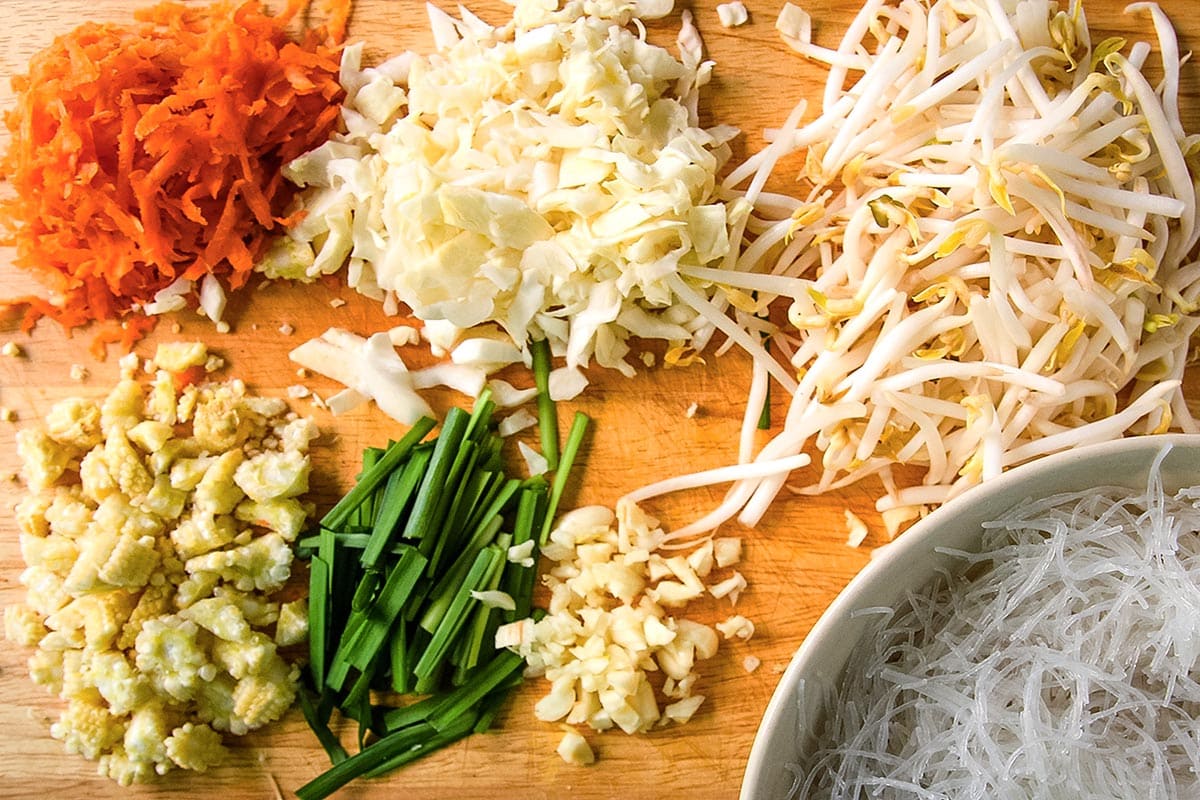
Glass Noodles
The filling consists of glass noodles with a lot of crisp veggies like cabbage, carrots, and bean sprouts. Glass noodles are noodles that look like clear glass when soaked or cooked. These are quite different from rice noodles. They are similar to rice noodles in that they cook soft, but they have a heaviness to them that makes them perfect for filling these Thai spring rolls. There are variations of glass noodles in Asian cuisine; mostly they are made from mung bean, potato, sweet potato, or tapioca starch.
The Umami Ingredients
The filling is flavoured with a combination of fish sauce and oyster sauce for the fishy umami note that is a signature in Thai cuisine. If you don't cook with fish sauce often, go ahead and buy a bottle anyway. Fish sauce has such a long life in the refrigerator that you will have it on hand for whenever you need it for Thai recipes in the future. Of course, if you need to make these on a whim, you can substitute with soy sauce in a pinch. The soy sauce would add a little saltiness and umami in a similar way. It just won't taste quite as authentically Thai.
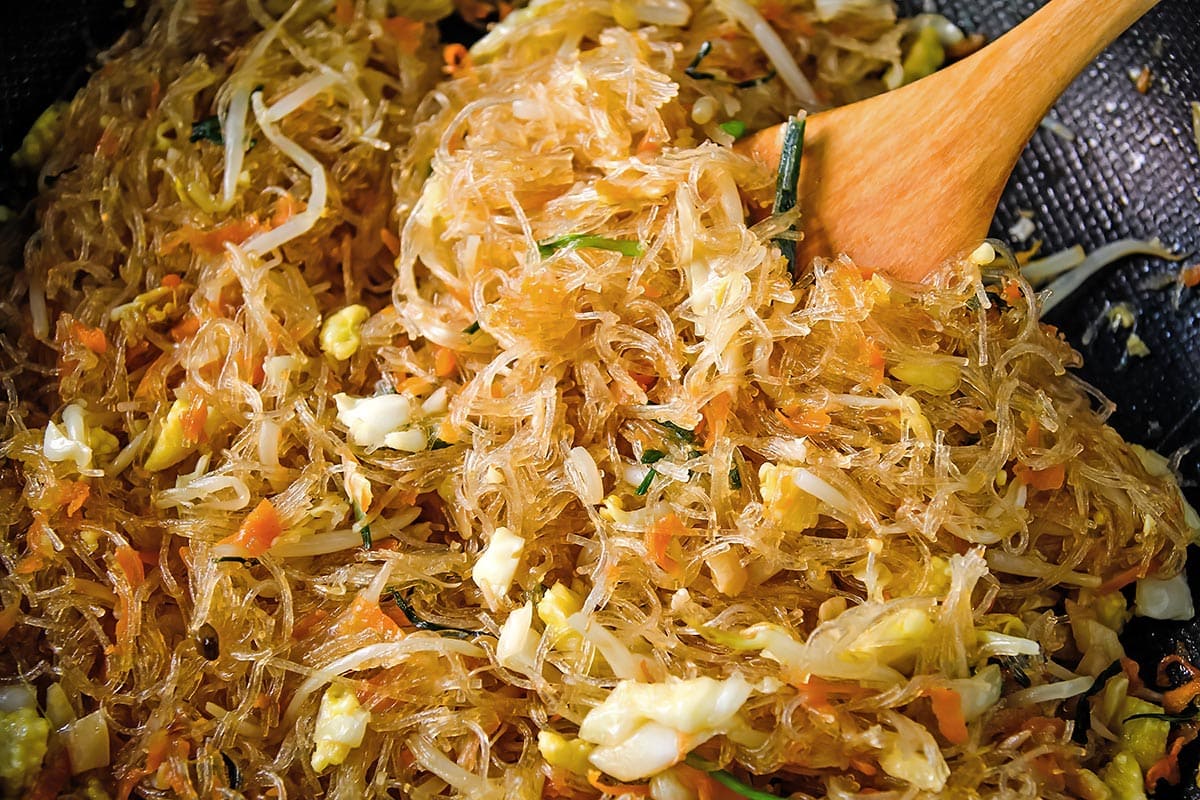
How to Shred the Vegetables
The cabbage and carrot in these spring rolls require shredding to ensure that they combine with the filling and cook in the same amount of time as the other components. You can definitely do this by hand if desired. It may just take some time. For the cabbage, simply quarter the cabbage, remove the core, and thinly slice with a knife. You may want to cut the shreds into smaller pieces so they incorporate with your filling more easily. For the carrots, you can slice them lengthwise into very thin pieces and then slice the opposite direction to achieve thin julienne shreds.
The easiest thing to do, though, is to use either a food processor (preferably with shredding discs) or a box grater. This will yield uniform pieces quickly. If you don't have shredding discs and are simply pulsing the veggies using a food processor, make sure to keep an eye on them. They can break down quickly and you don't want them too fine so that they become lost in the filling.

How to Roll Spring Rolls
The most daunting part of making spring rolls may be rolling them. This might take some practice, but they don't necessarily have to be perfect on the first try. This recipe makes about 12 spring rolls so you will have several to practice with.
It is important not to overdo the filling, but you still want enough to fill the spring rolls up. Two tablespoons are really the perfect amount. Just place it on the lower third of the spring roll wrapper, fold the bottom over and the left and right sides inward. Next, you just have to roll the spring rolls from the bottom to the top, using some water to seal the edges. The sealing really important as you don't want the filling to come out during frying.
If you have trouble finding spring roll wrappers at your grocery store, sometimes they may be kept in the freezer section rather than on the floor with other Asian items. Alternatively, you may want to seek out an Asian grocery store to find spring roll wrappers. Generally, they aren't very difficult to find in larger cities or places with significant Asian communities. However, if you are in a rural community, you may have to do some homework before shopping or purchase them online.
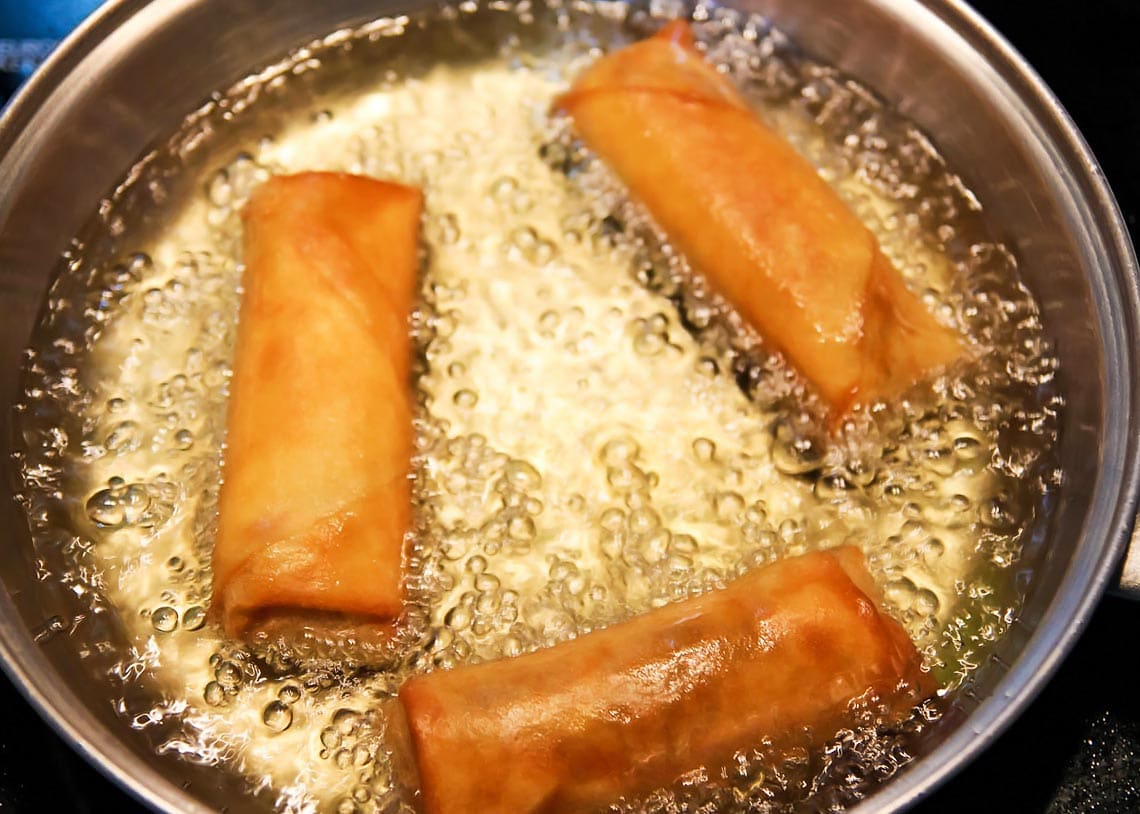
How to Fry Spring Rolls Safely
Many people avoid frying food because they deem it unsafe. It definitely can be if one isn't careful, but it is actually quite easy once you know how.
One good rule of thumb is to always use a high-edged pan or pot and never fill it with oil right to the top. The reason is that higher edges keep you safer and eliminate the chance of the oil bubbling over when you add the spring rolls.
To save on oil I am doing more of a shallow fry. I add enough oil to submerge only half of a spring roll (about 1-2 inches deep). Then I flip them several times during cooking using tongs to ensure they brown evenly from all sides.
Using a metal slotted spoon is great for both adding the spring rolls and removing them. This will ensure that your hands don't get too close to the oil when you are adding the food. The slots will also allow excess oil to drain off when removing the rolls.
A final thing is to never move the pan until the oil has cooled completely. You want to minimize the chance of any accidents with hot oil. Otherwise, stand back and have fun! Frying is really very safe and easy once you get the hang of it. Once they are golden and fried, they will be perfect for picking up your choice of dipping sauce.
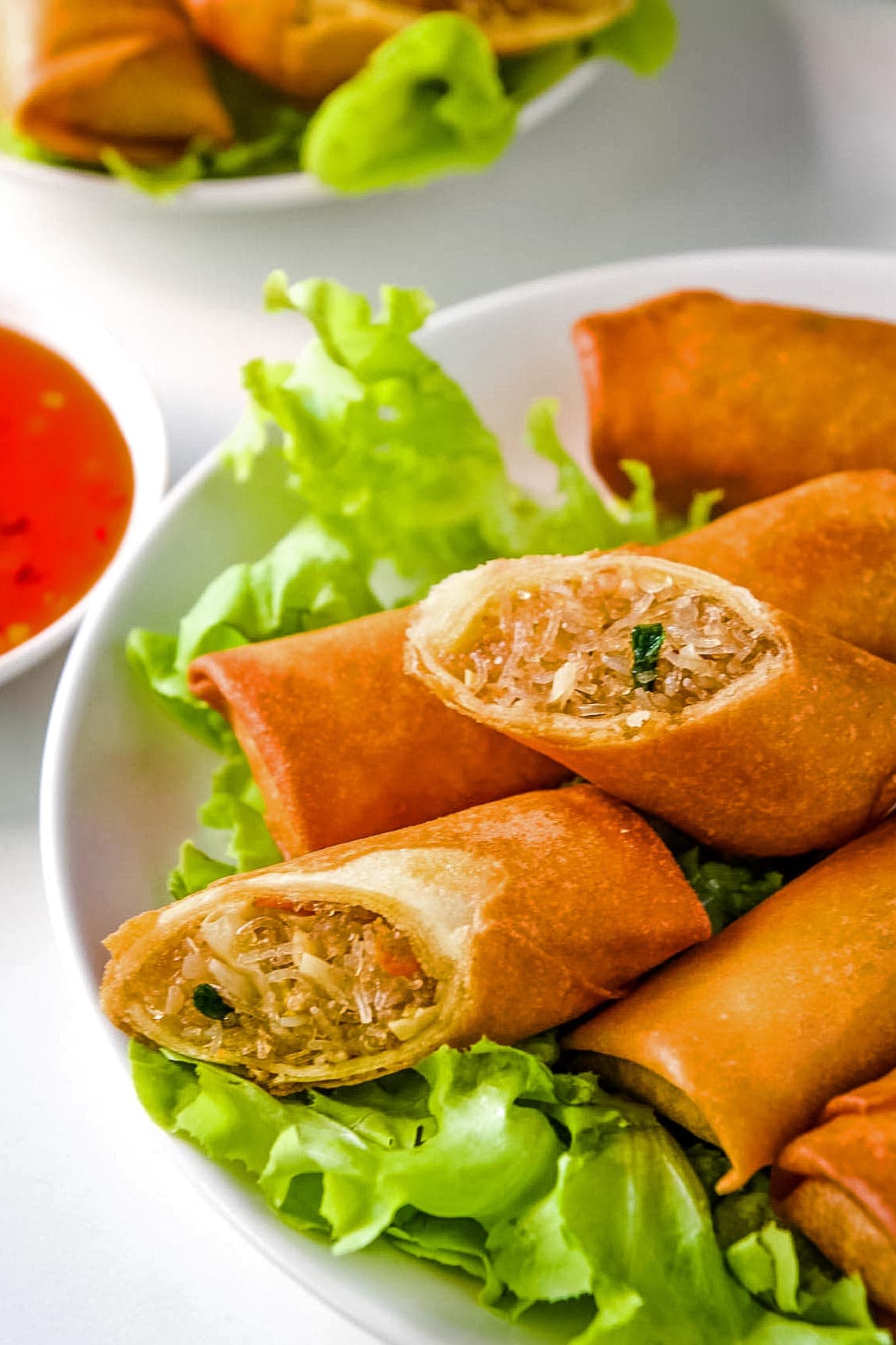
What to Serve Thai Spring Rolls With
These crispy appetizers are the best with my Thai Sweet Chili Sauce recipe. It is a sticky, sweet and slightly spicy sauce that just clings to the crispy edges of each spring roll. It includes liquid honey, ginger, garlic, chili, and vinegar simmered into a thick sauce.
If you aren't a sweet chili fan, you could serve with a dipping sauce of plum sauce or even just some soy sauce. Full salt soy sauce, low sodium soy sauce, coconut aminos, or tamari would all be excellent quick dipping sauces if you don't have time to make the Thai sweet chili sauce. You may even decide to blend some soy sauce with a little honey, sriracha, vinegar, sesame oil, garlic, ginger, and green onions for something akin to a dumpling sauce. This soy sauce blend would also be extremely tasty as a dipping sauce.
Even a spicy peanut sauce with peanut butter and chili would be great for dipping these crispy morsels into. My favourite blend of peanut sauce includes coconut milk and natural peanut butter. There is also some coconut sugar, soy sauce, vinegar, and red curry paste for a spicy note. I prefer natural peanut butter when making savoury recipes like homemade peanut sauce as other versions tend to have sugar in them. However, if you can't have peanuts, even some almond butter could work well. The red curry paste is a fragrant mixture that frequently includes chili, garlic, lemongrass, cilantro, and shrimp paste. If you love cooking Asian food making peanut sauce, I highly recommend that you keep some on hand, and especially for when you intend to make your favourite Thai curries.
More Spring Roll Recipes You'll Love:
Recipe
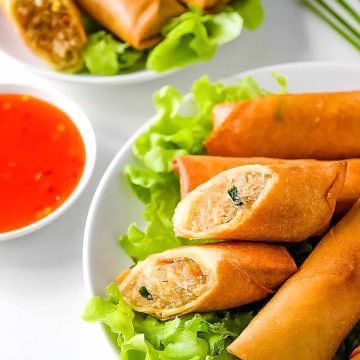
Thai Spring Rolls
Ingredients
- 3.5 oz glass noodles soaked to directions, cut to 1" length
- 3.5 oz bean sprouts
- 1.5 oz shredded cabbage
- 1 oz sliced baby corn
- 1 oz shredded carrot
- ¼ cup garlic chives cut to 1" length (or green onion)
- 3 garlic cloves finely chopped
- 2 tablespoons fish sauce
- 3 tablespoons oyster sauce
- 2 tablespoons oil more for deep frying
- 10-12 spring roll pastry wrappers
For Dipping:
Instructions
- Heat 2 tablespoons of oil on medium in a wok or frying pan. Add garlic and cook until browned.
- Stir in bean sprouts, cabbage, baby corn, carrot, and garlic chives. Add fish sauce and oyster sauce and stir to combine.
- Add in the soaked and drained glass noodles, stir fry until done; then remove pan from heat.
- Place 2 tablespoons of the filling on the lower third of a spring roll wrapper. Fold over the bottom edge, then fold in the left and right side.
- Brush a little water on the top edge and finish rolling up the spring roll.
- Repeat rolling spring rolls with the remaining filling.
- Heat frying oil on high heat (it should be at least 1" deep). To test if the oil is hot enough, hold one end of a spring roll into it. If big bubbles form around it, the oil is hot enough.
- Deep fry a few spring rolls at a time, you don't want to crowd the pan. Flip them a couple of times, until the spring rolls are golden brown. Transfer to a plate lined with paper towel to drain excess oil.
- Serve spring rolls with Thai sweet chili sauce.
Nutrition
Pin for later?
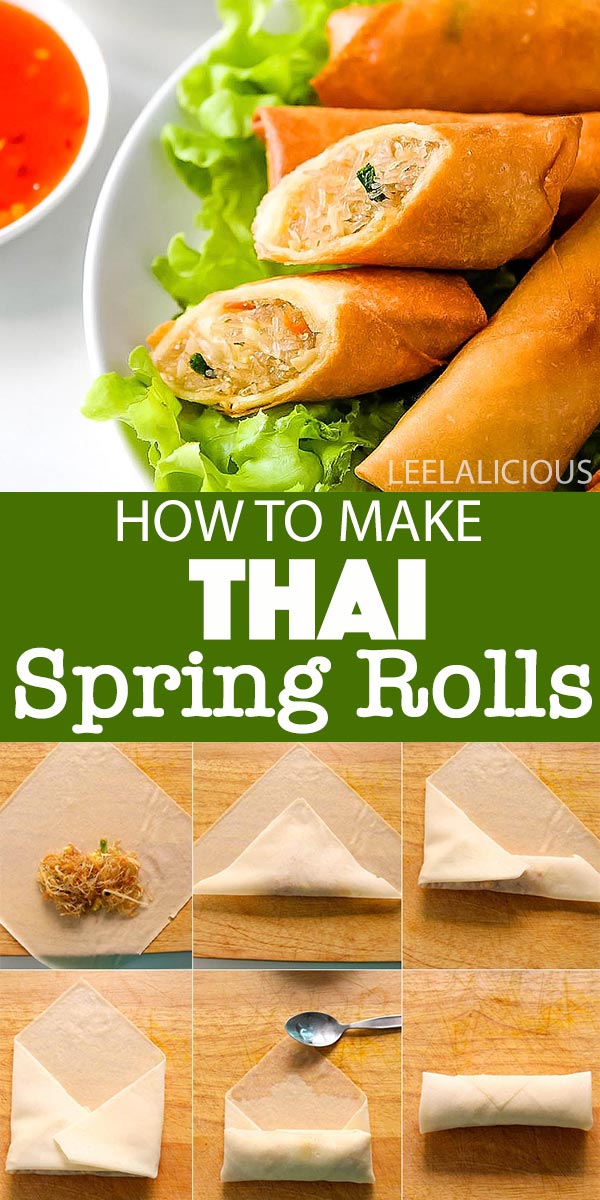
Random Questions
Thai spring rolls typically contain glass noodles, vegetables such as cabbage and carrots, and umami ingredients like fish sauce and oyster sauce.
Chinese spring rolls are often filled with a cabbage mixture and wrapped in an egg-based wrapper, whereas Thai spring rolls use spring roll wrappers and include glass noodles and distinct Thai flavors.
While they can be a flavorful and nutritious choice due to the vegetables and lean fillings, the frying process adds calories. Baking or air-frying could be healthier alternatives.
Thai summer rolls, also known as fresh spring rolls, are usually made with rice paper or lettuce and contain fresh, uncooked ingredients, while Thai spring rolls are typically fried and contain cooked fillings.


Elyse
Can you prep ahead of time and fry right before you serve? Any make ahead tips would be much appreciated!!
Jennifer @ Leelalicious
Hi Elyse, you definitely could prepare the spring rolls ahead and fully assemble them if you like. In that case, I recommend that you lay them in a single layer on a baking sheet that will fit in your fridge. You should cover them with damp paper towels to ensure that the spring roll wrappers don't dry out before you intend to fry them.
Rose
Can The spring rolls be done in the air fryer?
Regina | Leelalicious
I have not tried it, but I think with a light spray of oil they should be good in the air fryer